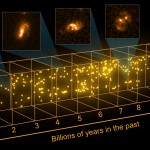W. M. Keck Observatory press release…
A group of astronomers from the University of Hawaii at Manoa, the U.S. Mainland, Canada, and Europe recently used the twin telescopes of the W. M. Keck Observatory on Mauna Kea, Hawaii, to conduct a census of the brightest, but until now unseen, galaxies in the distant Universe, bringing astronomers one step closer to understanding how galaxies form and evolve.

While it’s not clear what gives these galaxies their intense luminosity, it could be the result of a collision between two spiral-type galaxies, similar to the Milky Way and Andromeda Galaxies. Or they could be in a particularly gas-rich region of space, where galaxies form stars quickly due to constant bombardment from gas and dust.
Continue reading “Astronomers Go Infrared to Map Brightest Galaxies in Universe”
